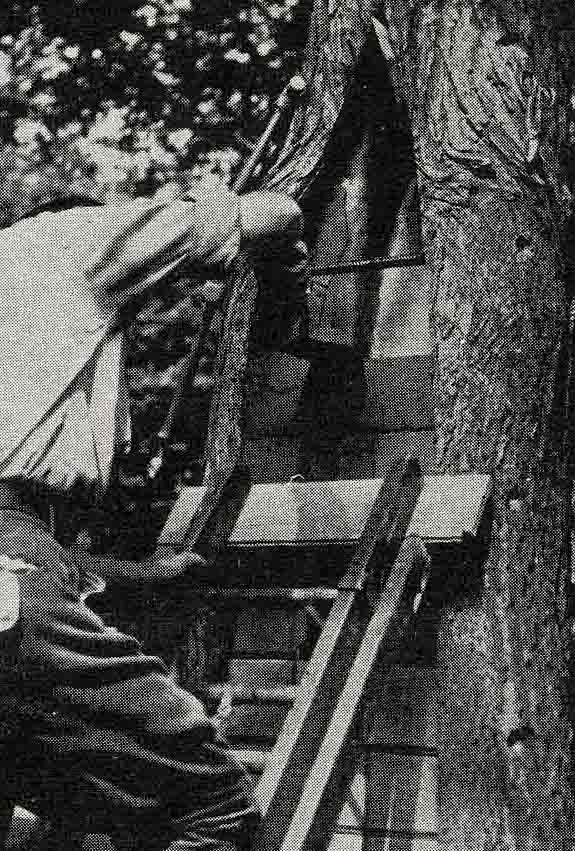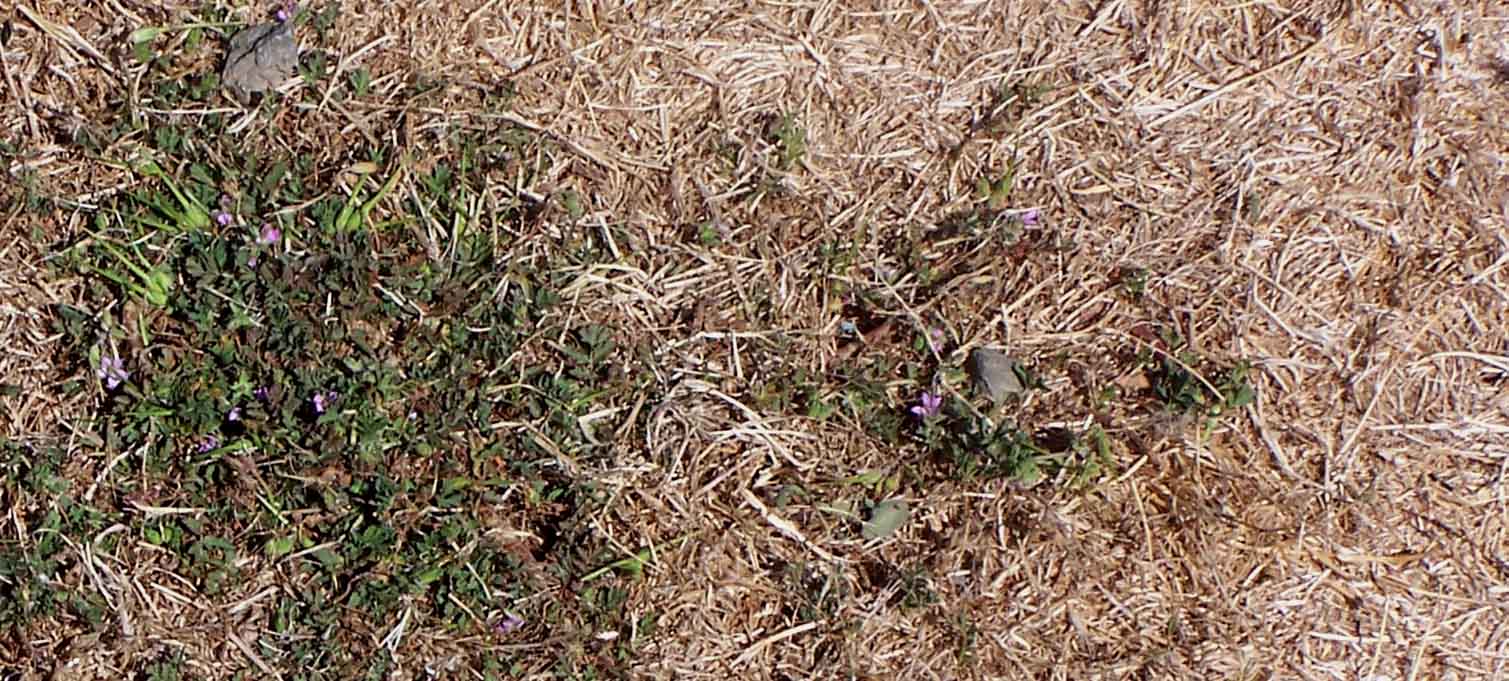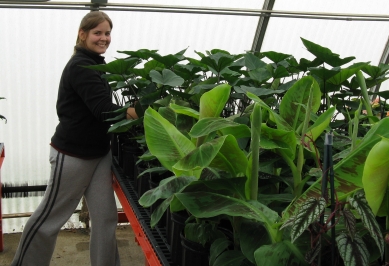Our good friends and fellow gardeners at Garden Rant just gave us a big thumbs up:
Thanks, ladies! We love you!
Our good friends and fellow gardeners at Garden Rant just gave us a big thumbs up:
Thanks, ladies! We love you!
I’m one of those people who can’t resist things that are free. When you pass a yard that has a ‘FREE’ sign on a rusted-out lawn mower or an old piece of exercise equipment and wonder, “Who on earth would take that home?” Uh… that would be me. Actually, I blame my dad. The Old Man’s garage was crammed full with outboard motors missing pull-cords, mismatched lawn furniture, and all manner of secondhand tools in varying states of disrepair. So my defect is genetic. Only my hyper-organized wife prevents my garage from suffering the same fate as my dad’s. But, like a blind pig finds an acorn, sometimes a scavenger finds something interesting. Recently a retiring professor in our building was cleaning out his office and put a stack of old books on a table by his door. And there was the magic word: FREE. I sifted through the stack and found my treasure; a 1948 edition of Maintenance of Shade and Ornamental Trees by Dr. P.P. Pirone. Granted, I have ready access to several modern tree care texts plus an ocean of information on the International Society of Arboriculture (ISA) website, but after thumbing through a few pages I knew this one was a keeper. The main reason the Pirone book interested me was to see how tree care has changed over the years and how things have stayed the same.
What’s changed? The most obvious example of how tree care has changed in 60-plus years is that an entire chapter of the 1948 text is devoted to cavity filling. For those not familiar with the process; cavity filling, as the name implies, is the practice of filling hollow areas in trees with concrete, just as a dentist fills a tooth cavity with amalgam or composite materials. Filling cavities in trees was once a relatively common practice. Today we recognize that filling does not stop decay and there is little value in the practice (and it certainly complicates removals). If anything, we would replace this chapter with ‘hazard tree assessment’, seeking to determine if the tree has enough solid wood to be structurally sound.

Filling a tree cavity.

The finished job
What hasn’t changed? I was surprised to see a fairly lengthy discussion of problems related to girdling roots from 60 years ago. This actually causes me to eat a little crow. I have sometimes questioned whether the current ‘epidemic’ of girdling roots is actually related to the fact that arborists and urban foresters are spending more time looking for them and have better tools (specifically air spades) for finding them. Of course, Pirone’s text also suggests that girdling roots were an issue before the advent of evil nursery production systems such as container growing. The discussion of treating girdling roots points out another change in practices. In 1948 the arborist was advised to carefully dress the wound with paint or tar. Today we generally advise against treating wounds except for situations which risk certain exposures such as if oak trees must be pruned when they are at risk for infection from oak wilt.

Girdling root removed and wound dressed.
So there you go, another book to clutter my shelf and another example of one man’s trash turning into another man’s treasure. I think Dad would have been proud.
Astute readers pointed out several morphological adaptations found in drought-tolerant turf weeds: fleshy taproots, reflective leaf surfaces, etc. What we can’t see is what many of these plants do physiologically – and that’s photosynthesize using a biochemical pathway that temperate turfgrasses don’t possess.
This pathway, called C4 photosynthesis, contains some extra preliminary steps not found in plants using traditional (C3) photosynthesis. The downside: it takes more solar energy for the plant to photosynthesize. The upside: these extra steps allow the plant to "fix" carbon (transforming it from gas to solid) faster, especially when it’s sunny, warm, and droughty. Practically speaking, this means that C4 plants do not have to keep their stomata open as long and they conserve water more efficiently than C3 plants.
So in the summer – when it’s hot, sunny and dry – the C4 plants in your lawn are operating under optimal conditions, while the C3 grasses go dormant. The tables turn when the seasons do: cool, moist conditions favor traditional photosynthesis, and the C4 plants are overtaken by the turfgrasses.
Cool, huh?
It’s still cold and wintery, so let’s imagine ourselves in a happy place…warm, sunny, dry…with dead lawns.

As the photo shows, the turfgrass is dead; this happens every summer during the Pacific Northwest’s droughty summers. Yet many of the weedy species are obviously thriving. Why?
Remember, this is a physiology quiz. You can discount herbicides, fertilizers, etc. This is a cool (no pun intended) adaptation that many species native to dry, subtropical to temperate environments possess. And there are serious implications for water use related directly to this adaptation, or lack thereof.
Let’s see lots of brainstorming on this – no points deducted for trying! (And if you are a true ecophysiology geek, let other people try first before posting the answer.)
I promise I’ll post a Friday puzzle later. But I just had to let you know that if you Google “water droplets burn leaves” (without quotes) you’ll get 436,000 hits as of this morning. Number 3 on the list? Our blog!
I think I’ll discuss this paper one more time on Wednesday – there are several other serious issues that I think are worth mentioning.
Have a good weekend!
The thing about being a horticulturist and a professor is that you’re always supposed to have the right answer. Which is to say, when I tell people not to use beer as a fertilizer, to avoid planting trees too deeply, and to reduce pesticide use, people take it for granted that I know what I’m talking about and that, if they don’t do what I say, there could very well be problems. But, as most of you know, growing plants is an art and a science, and sometimes plants decide to do things that are unexpected — plants are individuals after all, just like we are. Anyway, I was reminded of this today by this image of trees being planted on the St. Paul campus of the University of Minnesota in 1909.

How many things can you find wrong with the practices in this picture? And yet this ended up being a successful planting. I like to think we, as horticulturists and researchers, do a decent job of figuring out the best practices for planting and caring for plants, but the truth is that each plant is an individual and every situation is different and so often our predictions end up being wrong. And I think that’s a good thing.
I’ve got a good post for today…but have a seminar to give this morning and the blog has to wait. If you have time, go onto the web and look for “water drops burn leaves” or something like that. You’ll find reference to an article in New Phytologist that has the gardening world all a-twitter. I’ll be dissecting the paper – and the surrounding hype – later today.
You all remember the story of Chicken Little, right? Chicken Little thought she’d been hit on the head by a piece of the sky and ran around alarming the rest of the barnyard animals, who assumed Chicken Little knew what she was talking about. Had they not all been eaten by Foxy Loxy, I’m sure they would have felt foolish discovering that an acorn, not a piece of the sky, had bopped Chicken Little on the noggin.
On to today’s science rant.
Ann McCormick, one of my GWA (Garden Writers Association) colleagues, alerted me to an online story from Live Science entitled “Water Drops Magnify Sunlight and Burn Leaves.” A quick look at the internet shows that this report has gone viral, with similar headlines from other websites including the venerable Scientific American (“A study in the journal New Phytologist confirms the gardener’s belief that droplets of water resting on some types of leaves can focus sunlight until the plant’s surface actually burns”). It gets more and more ridiculous by the day (“Sun shining? Then don’t water your plants” courtesy of the Daily Mail in London; “Water droplets can form forest fires” from Calcutta). And so on.
I tracked down the original article in New Phytologist, entitled “Optics of sunlit water drops on leaves: conditions under which sunburn is possible.” You should take a look at it, if only to become completely intimidated by the physics and computer modeling it contains. I’ll be honest – I didn’t even try to understand this portion but focused on the plant science.
The authors had three actual experiments in addition to the optical modeling. The first experiment involved placing glass spheres on detached leaves (Acer platanoides – Norway maple) and exposing them to sunlight. Yup, glass spheres caused leaf burn on sunny days – no big surprise there. The second experiment substituted water droplets for the glass spheres and tested Ginkgo biloba as well as maple leaves. Not surprisingly (to me anyway) there was no damage to leaves of either species. The third experiment repeated the second, but tested the leaves of the aquatic fern Salvinia natans and voila! Leaf damage!
I have a lot of issues with this paper and maybe we’ll have to extend blog coverage for a day or two to keep today’s discussion as short as possible. Let me point out just two of the experimental problems
The leaves for experiments 1 and 2 were detached from the plant prior to treatment. How a detached leaf resembles anything in a natural situation is beyond me. Furthermore, these leaves were laid out, covered with glass spheres or water droplets, and left in the full sun for as long as nine hours. (Even so, the leaves covered with water droplets didn’t burn! You go, detached leaves!)
The Salvinia experiments were conducted on leaves scooped out of a pond, placed in two containers, sprinkled with water, and left in the sun for two hours. Then, in the authors’ words, “the experiment was concluded by cutting and scanning several Salvinia leaves – still holding water drops – in the laboratory in order to document their sunburn.” We are not told (a) how many leaves were scanned, (b) how the leaves were chosen, since they didn’t scan them all, and (c) how the reported damage was proven to be from water droplets. >Worse, there are no statistical data. We are simply asked to believe their report in the absence of any evidence except a handful of photographs. (As an aside, I really would like to know how they were able to cut and transport leaves without the water droplets moving!)
The lack of scientific rigor in this article is disappointing, especially in a peer-reviewed journal. Is there any plant scientist would consider detached leaves to be a model for those on an intact plant? Is there any gardener who would consider an aquatic fern comparable to trees and shrubs? Would any species – including aquatic ferns – easily burned by the combination of water and sunlight survive in the real world for long? I don’t think so – hence my myth posting on this very topic several years ago.
Let’s review: leaves of one species of aquatic fern was damaged by something – possibly sunlight – but without enough data presented to really evaluate the claim. None of the tree leaves tested were affected, even though they were detached from the plant and could not benefit from transpirational cooling. Yet the alarm has gone out! Don’t water your garden plants when it’s sunny, or the leaves will burn!!!
Be sure to take everything you read with a grain of salt – or an acorn.
(I will continue discussion of this article further if there is enough interest – that means you need to post a comment!)
The best part of my job is teaching, especially the plant production course (kind of Floriculture and Nursery management rolled into one). Today all the students are back on campus, and it’s an energy infusion for me, after weeks of quiet and mountains of paperwork. I made copies of the syllabus, and walked in to a class full of unsuspecting and slightly stand-offish students. They stared at the list of plants I handed them for the "crop lottery", where they draw for what they will be growing for the semester – from classic red geraniums to cutting-edge Colocasia (bartering is allowed for 5 minutes). They’re faced with the daunting responsibility of bringing a crop from propagation stage to market in a mere 14 weeks, on top of all the other work their class schedules throw at them. I must say, the indifference exuded by 19- and 20-year-olds can be palpable.
What I already know is that by the end of the semester, they will have…bonded over stacks of pots and wheelbarrows full of growing media; made 34 extra trips to the greenhouse to water and fertilize; critiqued each other’s growing skills and resultant products; quibbled over pricing their plants for the Hort Club Plant Sale; fretted over bud removal and pinching timing; freaked out over fungus gnats; and pleaded for another gorgeous hanging basket to take home to their family. The joy of growing plants; of having a tangible, living, breathing (transpiring) thing to show for your academic efforts, is indisputably gratifying, as well as a hell of a lot of fun – especially when compared to chemistry lab. But I’ll let them figure that out.

Alicain Carlson of the 2008 class shows off her tropicals grown from tissue culture starts, all ready for the Big Plant Sale. She’s now a graduate student in Horticultural Science at North Carolina State University and hopes to pass all this on to her future students.
One of the roles I’ve evolved into over the past decade as an extension specialist at MSU is that of ‘the Conifer Guy’. Conifers are great and fascinating plants. The oldest trees in the world are conifers, the largest trees in the world are conifers, and some of the most interesting (at least to me) landscape plants are conifers. Unfortunately, for a variety of reasons, in the Upper Midwest we have gravitated to Colorado blue spruce more than just about any other conifer. Part of this over-reliance on blue spruce in the landscape is driven by production (see, Linda, I’m not always an apologist for nurseries). Growers want to grow what they know and what’s easy to grow. As a nursery tree, blue spruce is a reliable performer that is well adapted to a relatively wide range of site conditions. Of course, growers also want to grow what they can sell, and there always seems to be a steady demand for blue spruce. In many neighborhoods it appears that there is an ordinance that every other tree has to be a blue spruce. So what’s the issue? In the Great Lakes region, blue spruce often look pretty good when young. However, as trees age they become susceptible to several major pests, especially cytospora canker and gall adelgid. So all those shapely blue Christmas trees that were planted 10 or 15 years ago are now a bunch of ratty-looking messes. So what’s the solution for blue spruce burn-out? Clearly landscapers and homeowners need to think beyond blue spruce and look for a greater variety of choices. Here are three to consider.
– Serbian spruce Picea omorika Whenever I’m asked to suggest a conifer, Serbian spruce is usually one of the first trees in the conversation. While the color may not be as striking as a blue spruce, Serbian spruce still has impressive needles in its own right – bi-color with dark green on the upper side and silver below. Adding to Serbian’s charm is its graceful weeping habit.
– Swiss stone pine Pinus cembra The late, great conifer expert Chub Harper used to remark, “I never met a cembra I didn’t like.” Chub’s fondness for Swiss stone pine was well founded. Here is an understated, consistent landscape performer. Few pests, dark green needles and stately upright form.
– Korean fir Abies koreana It would be a stretch to consider Korean fir an alternative to blue spruce. While Korean fir is more broadly adapted than many of its pantywaist cousins in the genus Abies, it will still do best on the Holy Grail of moist, well-drained slightly acidic soils. Nevertheless, Korean is tougher than the average fir and is a conifer with some character and worth a shot. Korean firs are often heavy cone producers, which can add an interesting element of color.